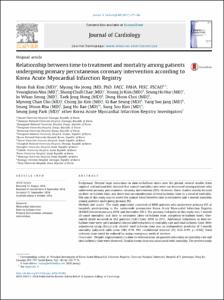KUMEL Repository
1. Journal Papers (연구논문)
1. School of Medicine (의과대학)
Dept. of Internal Medicine (내과학)
Relationship between time to treatment and mortality among patients undergoing primary percutaneous coronary intervention according to Korea Acute Myocardial Infarction Registry
- Keimyung Author(s)
- Hur, Seung Ho
- Department
- Dept. of Internal Medicine (내과학)
- Journal Title
- Journal of Cardiology
- Issued Date
- 2017
- Volume
- 69
- Issue
- 1
- Abstract
- Background :
Despite large reductions in door-to-balloon times over the period, several studies from regional and national data showed that annual mortality rates were not decreased among patients who underwent primary percutaneous coronary intervention (PCI). However, these studies mostly focused on door-to-balloon time, and there was no consideration of total ischemic time in a trend of mortality. The aim of this study was to assess the annual trend between time to treatment and 1-month mortality among patients undergoing primary PCI.
Methods and results :
The study population consisted of 8040 patients who underwent primary PCI at hospitals participating in the nationwide prospective Korea Acute Myocardial Infarction Registry (KAMIR) between January 2008 and December 2011. The primary end point of this study was 1-month all-cause mortality, and time to treatment (door-to-balloon time, symptom-to-balloon time). One-month death occurred in 452 patients (5.6%) from 2008 to 2011. Additional reductions in door-to-balloon time were not translated into parallel reductions in mortality rate and total ischemic time. After adjustment using clinical risk, shorter total ischemic time was an independent predictor of 1-month mortality [adjusted odds ratio (OR) 0.78, 95% confidential interval (CI) 0.62–0.99, p = 0.04]. Total ischemic time could be reduced by using emergency medical services.
Conclusion : Despite improvements in door-to-balloon time, no parallel reductions in mortality rate and total ischemic time were observed. Total ischemic time was associated with mortality. The present study suggests that additional efforts are needed to shorten total ischemic time including patient and pre-hospital systemic delay for better prognosis after primary PCI.
- Keimyung Author(s)(Kor)
- 허승호
- Publisher
- School of Medicine
- Citation
- Hyun Kuk Kim et al. (2017). Relationship between time to treatment and mortality among patients undergoing primary percutaneous coronary intervention according to Korea Acute Myocardial Infarction Registry. Journal of Cardiology, 69(1), 377–382. doi: 10.1016/j.jjcc.2016.09.002
- Type
- Article
- ISSN
- 0914-5087
- Appears in Collections:
- 1. School of Medicine (의과대학) > Dept. of Internal Medicine (내과학)
- 파일 목록
-
-
Download
 oak-2017-0193.pdf
기타 데이터 / 457.49 kB / Adobe PDF
oak-2017-0193.pdf
기타 데이터 / 457.49 kB / Adobe PDF
-
Items in Repository are protected by copyright, with all rights reserved, unless otherwise indicated.